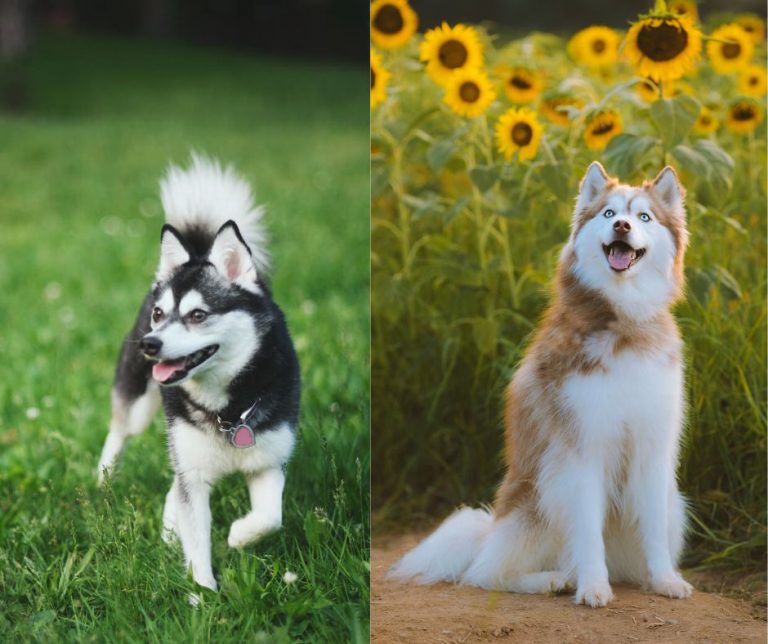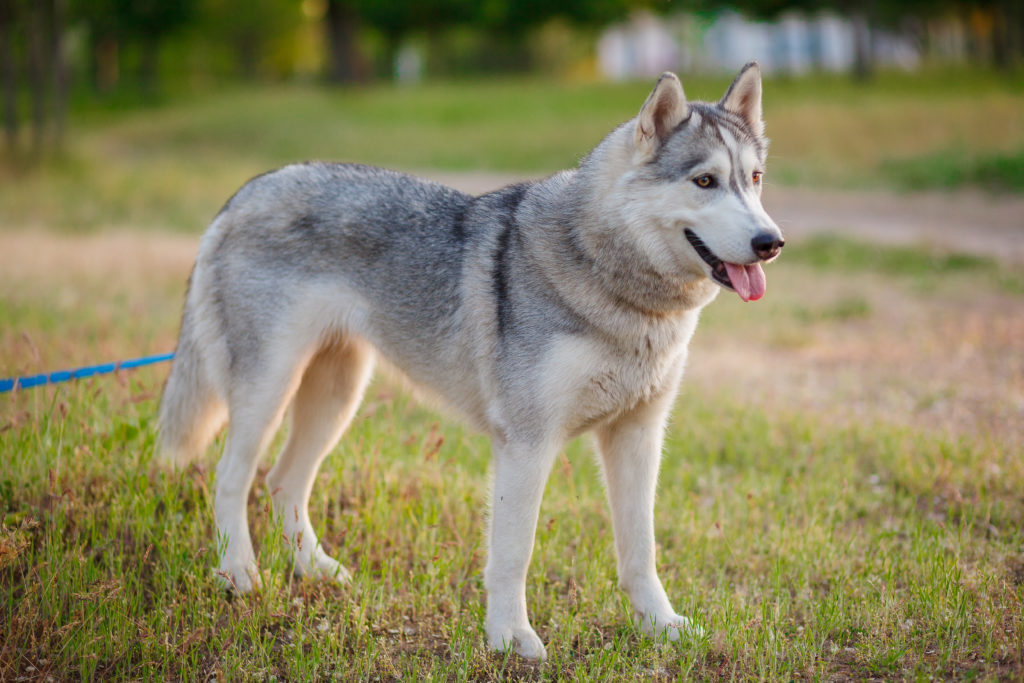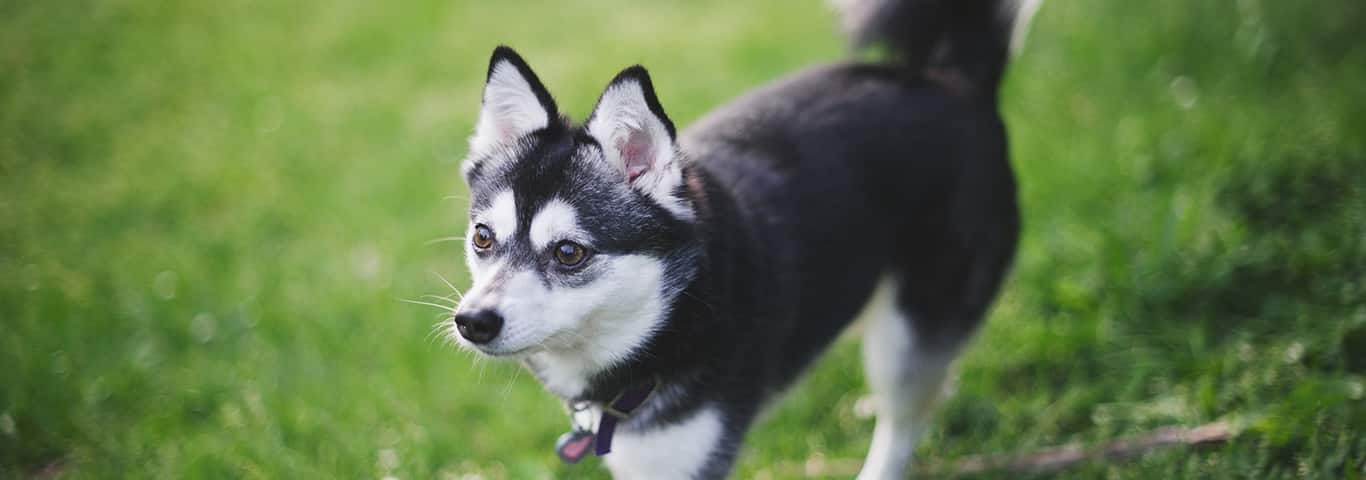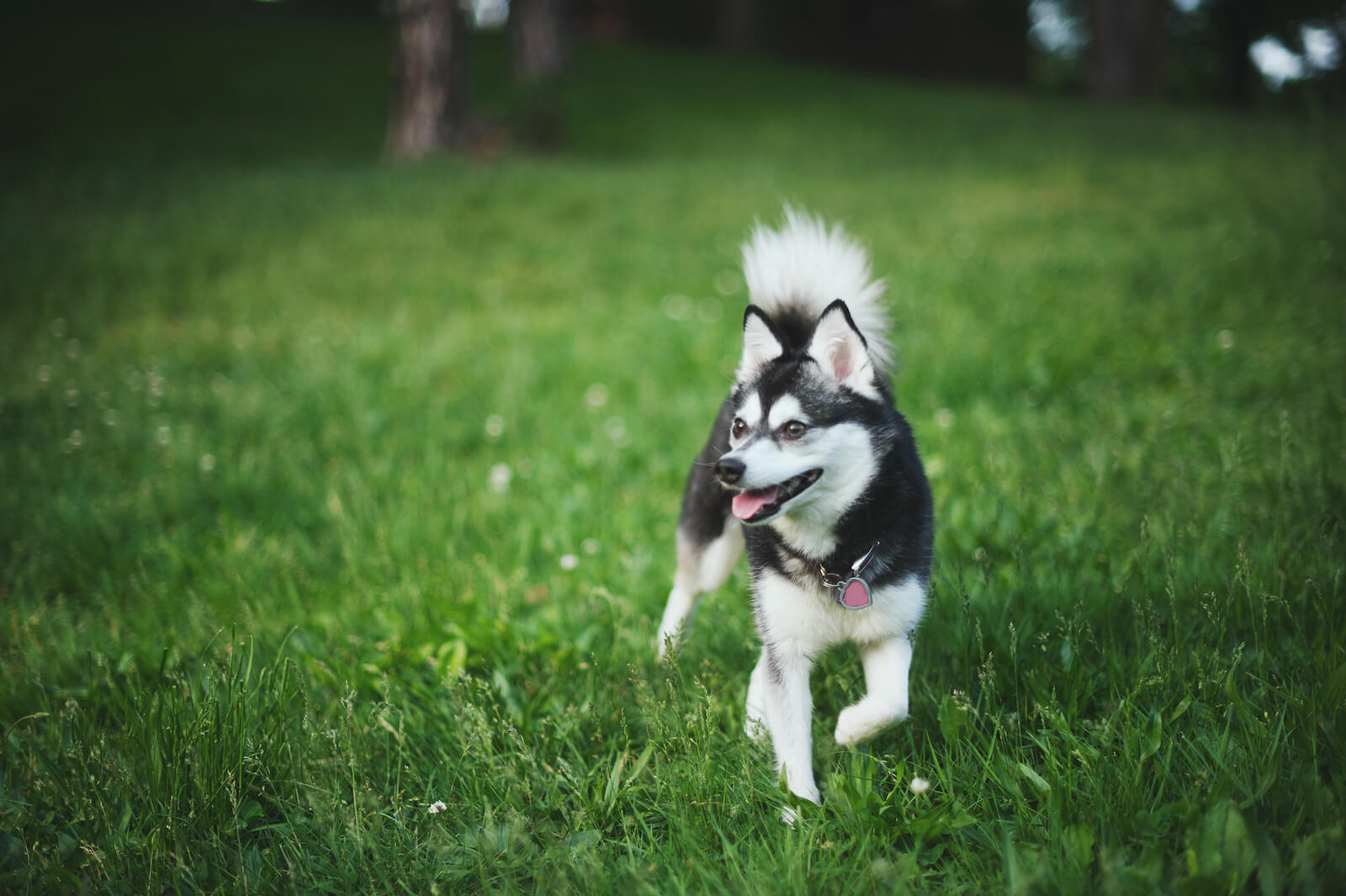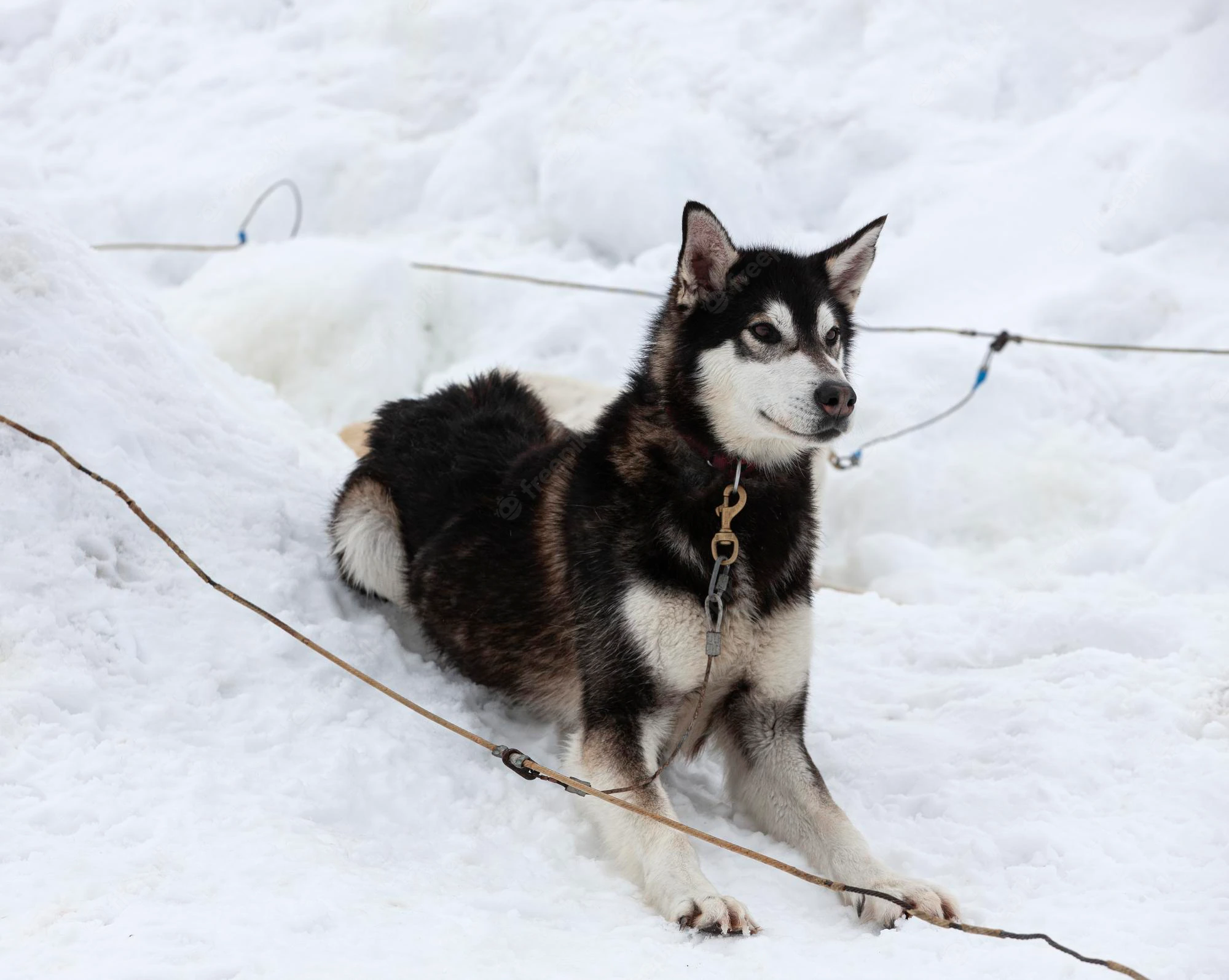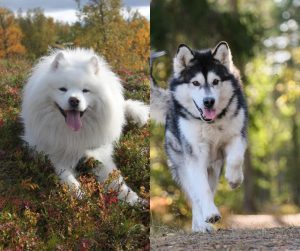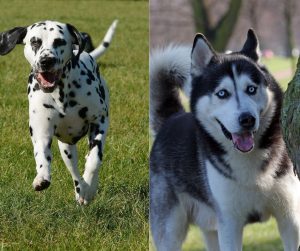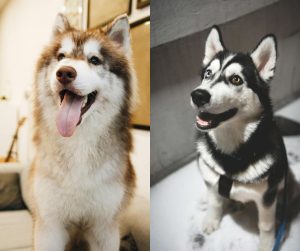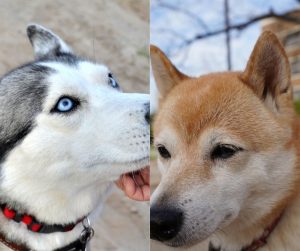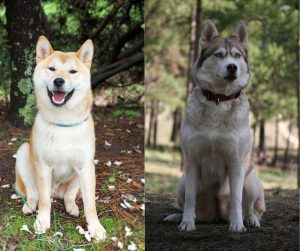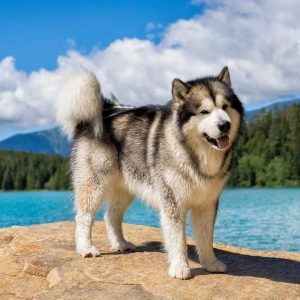As a dog enthusiast for most of my live, I’ve always loved to breeds that have a “husky” resemblance. When we talk about Husky breeds, there is only the Alaskan and Siberian Husky. But there are many breeds that look like a husky. And that can trick many people. For example, many consider the Alaskan Malamute a slightly bigger Husky, even though it is a separate breed. These two have captivating eyes and fluffy coats, yet, I’ve learned their personalities are quite different.
When choosing a furry companion, many potential dog owners find themselves comparing the Alaskan Klee Kai and the Siberian Husky. Both breeds share a striking resemblance with their wolf-like features and captivating eyes, which often leads to confusion between the two.
Although these cold-weather canines may look similar at first glance, they differ in many ways, from their size to their demeanor. The Alaskan Klee Kai is notably smaller, often being mistaken for Husky puppies, and this is one of the simplest ways to tell them apart.
The Alaskan Klee Kai, a relatively new breed, only emerged in the 1980s in Alaska, with the intent to create a companion-sized version of the Husky. Meanwhile, the Siberian Husky has a long history that dates back to ancient times, originally bred by the Chukchi people of Siberia for sled pulling and companionship,
As for their nature, the Siberian Husky is known for its friendly and sociable personality, whereas the Alaskan Klee Kai tends to be more reserved with strangers, showcasing a variety in typical breed demeanor. Physical distinctions continue beyond size, with the Husky typically sporting a medium-length coat, while the Klee Kai may possess varying coat lengths and colors.
Understanding these differences is crucial for potential owners to make an informed decision that suits their lifestyle, environment, and expectations from their future pet.
While the Siberian Husky demands ample space to accommodate its larger size and higher energy levels, the Alaskan Klee Kai may fit well in smaller living conditions due to its more diminutive stature and need for less vigorous exercise. Today, we will take a deeper look into the Alaskan Klee Kai vs Siberian Husky dog breed comparison.
Key Takeaways
- The Alaskan Klee Kai is significantly smaller than the Siberian Husky, making size a notable distinguishing feature.
- Alaskan Klee Kai were developed recently and are more reserved, while Siberian Huskies have ancient origins and are very sociable.
- Understanding the breeds’ differences in size, temperament, and energy levels helps ensure a suitable match for potential owners.
Origins and History
When diving into the origins and history of the Alaskan Klee Kai and the Siberian Husky, one uncovers a rich tapestry of canine development defined by the locales and peoples who bred them. Each breed carries a unique narrative that echoes through their lineage and characteristics.
Alaskan Klee Kai Origin
The Alaskan Klee Kai began as a dream in Alaska. In the 1970s, Linda Spurlin took notice of some smaller-sized Huskies during a visit to Oklahoma and saw potential for a new breed. It wasn’t until the mid-1980s that she started the meticulous breeding process in Alaska.
With the intention to create a companion-sized version of the Siberian Husky, her efforts resulted in the distinct and charming Alaskan Klee Kai that enthusiasts know and love today. They may be small, but their spirit and energy are as vast as the Alaskan landscape they originate from.
The Alaskan Klee Kai breed is available in different sizes. You can get a Miniature Alaskan Klee Kai dog, Toy Alaskan Klee Kai, or Standard.
Siberian Husky Heritage
The Siberian Husky’s story can be traced back to Northeast Asia. Known for their endurance and diligence, the Siberian Husky was bred by the Chukchi people of Siberia. These dogs were more than just pets; they were vital for transportation, especially during the harsh winters.
Their heritage is intertwined with the 1908 Gold Rush, which brought them to the hearts of North American dog lovers. This marked the turning point for the breed, as they soon became popular both on the sled trails and in family homes.
Physical Characteristics
When comparing the Alaskan Klee Kai and the Siberian Husky, one will notice significant differences in their physical traits. Let’s take a closer look.
Size Comparison
The Alaskan Klee Kai breed is much smaller than the Siberian Husky. On average, the Siberian Husky stands about 20-24 inches tall and the Alaskan Klee Kai stands 10-15 inches tall. Alaskan Klee Kais also have three size variants: Toy, Miniature, and Standard.
In contrast, Siberian Huskies don’t have different size classes. The weight further distinguishes them, with Siberian Huskies typically weighing between 35-60 pounds, compared to Alaskan Klee Kais, which range between approximately 10-40 pounds depending on the size variant.
Nowadays, because the Klee Kai is a bit smaller than a Siberian Husky puppy, many people call it the Miniature Husky or Mini Husky. But they are a different recognized breed. Or, some people call the Alaskan Malamute a bigger Husky. But that is another separate breed.
Coat and Colors
Both breeds possess a double coat that keeps them warm in cold climates. The Siberian Husky has a thicker coat that comes in colors like black and white, red and white, and gray and white.
Alaskan Klee Kais share similar coat colors, but they often have more pronounced markings. Their fur is equipped to handle the cold just as Huskies’ coats are, though it is often not as dense.
Eye Color Variations
Eye color is one feature where there’s a lot of variety for both breeds. Siberian Huskies are known for their striking blue or brown eyes, and they can even have one eye of each color, a condition known as heterochromia.
Alaskan Klee Kais also boast a range of eye colors including blue, brown, and even copper. It’s not unusual to see an Alaskan Klee Kai with two different colored eyes, adding to their unique appearance.
Temperament and Behavior
When choosing between an Alaskan Klee Kai vs Siberian Husky puppy, it’s important to understand that while they share a physical resemblance, their temperaments and behaviors present unique attributes. They cater to different lifestyles and understanding their traits is essential for a harmonious pet-owner relationship.
Character Traits
The Alaskan Klee Kai tends to be more reserved and cautious around new faces, reflecting a touch of independence and a dose of shyness. On the flip side, they’re often extremely affectionate with their own family.
The Siberian Husky‘s temperament is comparably sociable, displaying friendliness and a working dog zest for life that’s hard to match. Both breeds exhibit high intelligence which, paired with their curiosity, can lead to mischievous behavior if not properly stimulated.
- Alaskan Klee Kai:
- Reserved with strangers
- Affectionate with family
- Independent
- Siberian Husky:
- Sociable and friendly
- Energetic worker
- Intelligent and curious
Exercise Needs
An energetic disposition means that both breeds sport a high energy level, demanding ample exercise.
The Siberian Husky will enjoy long runs and is ideal for active people who can provide daily, vigorous exercise.
The Alaskan Klee Kai still needs regular activity but may have slightly less intense exercise requirements. What’s key is that both dogs’ exercise needs are met to prevent boredom-related behaviors, such as chewing or escaping. Due to their prey drive, secure areas for off-leash activities are recommended.
- Alaskan Klee Kai:
- Regular activity to match energy
- Secure areas for exercise due to prey drive
- Siberian Husky:
- Requires daily, vigorous exercise
- High energy level needs fulfillment
Health and Care
When considering an Alaskan Klee Kai vs Siberian Husky dog, it’s important to be familiar with their health needs and grooming requirements. These aspects are fundamental for their well-being and happiness.
Common Health Issues
Both Alaskan Klee Kai and Siberian Huskies might face genetic health concerns, so it’s wise for potential owners to understand what these canines might encounter.
Alaskan Klee Kai could develop cataracts or progressive retinal atrophy (PRA), which are eye conditions that can lead to vision loss. It’s prudent to schedule regular check-ups with a veterinarian to monitor their eye health.
Siberian Huskies are generally robust dogs, but they also can be prone to certain health issues. Hypothyroidism and cataracts are not uncommon in the breed. Knowing the signs and keeping consistent vet appointments help maintain their health.
Regular medical care plays a big role in managing and preventing health problems, which can help extend their lifespan, which typically ranges from 12 to 15 years.
Grooming and Shedding
For both breeds, their beautiful thick coats require regular grooming.
An Alaskan Klee Kai’s coat might not be as dense as a Siberian Husky’s, but they still shed, especially during the change of seasons. Brushing them a couple of times a week helps reduce the amount of fur left around the house and keeps their coat healthy. Yes, a Siberian Husky puppy might be hypoallergenic, only when mixed with breeds like Poodle, Yorkshire Terrier, or similar dogs that do not shed.
Siberian Huskies, with their medium-length thick coat, are known to shed heavily, especially during the spring and fall. They benefit from more frequent brushing, sometimes daily during peak shedding periods, to manage the amount of loose fur. Regular grooming sessions are not only a hygienic practice but also a good way for owners to check for any skin issues or parasites.
Training and Intelligence
When bringing a furry friend into your home, understanding how their brain works can make training a joy for both of you. Let’s explore how the Alaskan Klee Kai and Siberian Husky fare when it comes to training and keeping their clever minds engaged.
Trainability
Alaskan Klee Kai are known for their keen intelligence and can be quite easy to train if approached with consistent and positive reinforcement techniques. They respond well to obedience training, making them eager to please and quick learners.
Their smarts also mean they may get bored with repetition, so keep sessions lively and varied.
In contrast, the Siberian Husky, while intelligent, often exhibits a more independent nature. Their intelligence is sometimes hidden behind a stubborn streak, which means they might not always be the easiest to train.
Patience is key, and one might find that Siberian Huskies thrive with more innovative and challenging training exercises that pique their interest.
Mental and Physical Stimulation
Both breeds require ample mental stimulation to stay happy and well-behaved.
Alaskan Klee Kai, with their smart and sometimes mischievous personalities, enjoy puzzle toys and games that challenge their brain. They’re not just smart; they’re clever, so mix up their tasks and play to keep them guessing.
Siberian Huskies have a bundle of energy and their intelligence to match. They need both physical exercise and mental challenges to stay content. Without proper stimulation, they may find less desirable ways to entertain themselves.
Engaging in activities like agility courses can be a perfect way for Siberians to burn both mental and physical energy.
Breed Recognition and Status
When one is considering an Alaskan Klee Kai or a Siberian Husky, it’s essential to understand each breed’s standing with kennel clubs and how aspects like recognition can influence their popularity and price.
Kennel Club Recognitions
The Alaskan Klee Kai gained recognition from the United Kennel Club (UKC) in 1997, which was a significant milestone since its development in the 1980s. Before that, they were acknowledged by the American Rare Breed Association in 1995. As of now, they are yet to be recognized by the American Kennel Club (AKC).
On the other hand, the Siberian Husky enjoys a long-established status with major kennel clubs, including the AKC, wherein it has been a recognized breed for many decades.
Breed Popularity and Price
- Alaskan Klee Kai:
- Popularity: They have a dedicated following, mostly due to their rarity and unique appearance.
- Price: Their prices can vary greatly, but one might expect to pay a premium due to their recognized status with the United Kennel Club and limited breeding by reputable breeders.
- Siberian Husky:
- Popularity: Widely known and loved, their striking looks and friendly nature have earned them a place in many hearts and homes
- Price: Generally more affordable than the Alaskan Klee Kai, with the price reflecting their availability and AKC recognition
Choosing a dog from a reputable breeder is crucial for potential owners looking to bring home a healthy, well-socialized pup, regardless of the breed’s kennel club status.
Comparative Overview
When comparing the Alaskan Klee Kai to the Siberian Husky, one will find they share a common heritage yet exhibit clear distinctions in size, purpose, and temperament. This section will unravel these differences and similarities.
Differences Between Breeds
Size:
- Alaskan Klee Kai (AKK): Typically 10-17 inches in height
- Siberian Husky: Averages 20-24 inches in height
Breed Recognition:
- AKK: Not recognized by the American Kennel Club (AKC)
- Siberian Husky: Recognized by the AKC
Function:
- Alaskan Klee Kai: Primarily companion dogs
- Siberian Husky: Originally sled dogs and still serve as working dogs in some regions
Weight:
- Alaskan Klee Kai: Can weigh between 10 to 25 pounds
- Siberian Husky: Heavier, typically between 35 to 60 pounds
Similarities Across Breeds
Appearance:
- Both breeds share striking facial markings and can have similar eye colors
- Coat colors often resemble each other, though Huskies have a wider variety
Temperament:
- Both are known for their sociability and friendly dispositions
- They showcase intelligence and a playful nature, making them beloved by many
Heritage:
- Both breeds descend from sled dogs and retain that ancestral vigor
Exercise Needs:
- Both AKKs and Siberian Huskies require regular exercise to maintain their health and happiness
Cultural and Historical Impact
The Siberian Husky and Alaskan Klee Kai have left a distinct paw print in our history. From their shared lineage as sled dogs to their influence on our culture and hearts, these breeds are more than just companions; they represent a unique chapter in the story of human and canine collaboration.
Influence on Sled Dog Culture
Alaskan Husky and Siberian Husky breeds have been pivotal in shaping the sled dog culture. The Siberian Husky, with its roots tracing back to the Chukchi people of Siberia, was bred for endurance and the ability to haul light loads over expansive frozen lands. These dogs gained massive notoriety during the Gold Rush era as they were essential for transportation.
- 1925 Serum Run (Race for Life): The Siberian Husky played an illustrious role in the life-saving mission to deliver diphtheria antitoxin to Nome, Alaska. This event showcased the breed’s status as both working dogs and heroes. It is often affectionately referred to as the Great Race of Mercy
Representation in Media
The representation of these breeds in media has helped to solidify their presence in our cultural consciousness.
While the Alaskan Klee Kai is a newer breed and less prominent in media, the Siberian Husky has been frequently featured in films and books. It is often characterized by its striking appearance and spirit.
- Sled Dogs in Movies: The Siberian Husky’s heroic Serum Run contribution was depicted in the film Balto. The film combines the real-life tale with animated storytelling. It portrays the enduring bond between humans and their sled dogs, capturing the hearts of audiences and increasing the breed’s popularity
Understanding the historical significance and the media portrayal of these beloved breeds gives a deeper appreciation for their roles not just as pets but as icons of resilience and partnership between humans and dogs.

